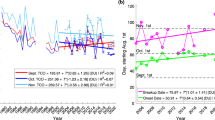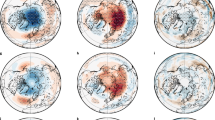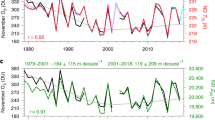Abstract
The notable rise in surface air temperatures over southern Africa over the past two decades is thought to largely result from the human-induced increase in atmospheric greenhouse gas concentrations1,2,3. In addition, the loss of stratospheric ozone over Antarctica is thought to have had a significant impact on tropospheric circulation, and hence climate, in the Southern Hemisphere summer4,5,6,7,8,9, by favouring the positive phase of the Southern Annular Mode4,10,11. Here, we use reanalysis data to compare the climate of southern Africa before and after the development of the large ozone hole, and investigate possible links between the development of the Antarctic ozone hole and summer warming in the region, defining 1970–1993 as the pre-ozone hole era, and 1993–2011 as the large ozone hole era. We find that the ozone-induced shift in the polarity of the Southern Annular Mode after 1993 coincided with an intensification of the Angola Low, a continental low pressure system that normally develops in austral summer and is mostly located over Angola. We show that the deepening of this low pressure system, in turn, was associated with an increase in the flux of warm surface air from the lower latitudes to southern Africa. We suggest that the recent summer warming over southern Africa is linked to these shifts in atmospheric circulation that are probably induced by Antarctic ozone loss.
This is a preview of subscription content, access via your institution
Access options
Subscribe to this journal
Receive 12 print issues and online access
$259.00 per year
only $21.58 per issue
Buy this article
- Purchase on Springer Link
- Instant access to full article PDF
Prices may be subject to local taxes which are calculated during checkout





Similar content being viewed by others
References
Shongwe, M. E. et al. Projected changes in mean and extreme precipitation in africa under global warming. Part I: Southern africa. J. Clim. 22, 3819–3837 (2009).
McCarthy, J. J., Canziani, O. F., Leary, N. A., Dokken, D. J. & White, K. S. (eds) IPCC Climate Change 2001: Impacts, Adaptation, and Vulnerability (Cambridge Univ. Press, 2001).
Joubert, A. M. & Kohler, M. O. Projected temperature increases over southern Africa due to increasing levels of greenhouse gases. South Afr. J. Sci. 92, 524–526 (1996).
Gillett, N. P. & Thompson, D. W. J. Simulation of recent southern hemisphere climate changes. Science 302, 273–275 (2003).
Thompson, D. W. J & Solomon, S. Interpretation of recent Southern Hemisphere climate change. Science 296, 895–899 (2002).
Hartmann, D. L. et al. Can ozone depletion and global warming interact to produce rapid climate change? Proc. Natl Acad. Sci. USA 97, 1412–1417 (2000).
Arblaster, J. M., Meehl, G. A. & Karly, D. J. Future climate change in the Southern Hemisphere: Competing effects of ozone and greenhouse gases. Geophys. Res. Lett. 38, L02701 (2011).
Shindell, D. T. & Schmidt, G. A. Southern Hemisphere climate response to ozone changes and greenhouse gas increases. Geophys. Res. Lett. 31, L18209 (2004).
Polvani, L., Waugh, D., Correa, G. & Son, S-W. Stratospheric ozone depletion: The main driver of 20th century atmospheric changes in the Southern Hemisphere. J. Clim. 24, 795–812 (2011).
Marshall, G. J. Trends in the Southern Annular Mode from observations and reanalyses. J. Clim. 16, 4134–4143 (2003).
Sexton, D. M. H. The effect of stratospheric ozone depletion on the phase of the Antarctic Oscillation. Geophys. Res. Lett. 28, 3697–3700 (2001).
Kang, S. M. et al. The impact of polar ozone depletion on subtropical precipitation. Science 332, 951–954 (2011).
Cataldo, M. et al. Mineral dust variability in central West Antarctica associated with ozone depletion. Atmos. Chem. Phys. 13, 2165–2175 (2013).
Manatsa, D., Reason, C. J. C. & Mukwada, G. On the decoupling of the IODZM from southern African rainfall variability. Int. J. Climatol. 32, 727–746 (2011).
Xue, F., Wang, H. J. & He, J. H. Interannual variability of Mascarene High and Australian High and their influence on the East Asian summer monsoon. J. Meteorol. Soc. Japan 80, 173–1186 (2004).
Tyson, P. D. & Preston-Whyte, R. A. The Weather and Climate of Southern Africa (Oxford Univ. Press, 2000).
Garzoli, S. L. & Gordon, A. L. Origins and variability of the Benguela Current. J. Geophys. Res. 101, 897–906 (1996).
WMO (World Meteorological Organization). Scientific assessment of ozone depletion: 2002. Global Ozone Research and Monitoring Project-Report No. 47 (Geneva, Switzerland, 2003).
Baldwin, M. P. & Dunkerton, T. J. Propagation of the Arctic Oscillation from the stratosphere to the troposphere. J. Geophys. Res. 104, 30937–30946 (1999).
Miller, R. L., Schmidt, G. A. & Shindell, D. T. Forced annular variation in the 20th century Intergovernmental Panel on Climate Change Fourth Assessment Report models. J. Geophys. Res. 111, D18108 (2006).
Reason, C. & Rouault, M. Links between the Antarctic Oscillation and winter rainfall over western South Africa. Geophys. Res. Lett. 32, L07705 (2005).
Gillet, N. P., Kell, P. D. & Jones, P. D. Regional climate impacts of the Southern Annular Mode. Geophys. Res. Lett. 33, L23704 (2006).
Purich, A. & Son, S-W. Impact of Antarctic ozone depletion and recovery on Southern Hemisphere precipitation, evaporation and extreme changes. J. Clim. 25, 3145–3154 (2012).
Newman, P. A. et al. When will the Antarctic ozone hole recover? Geophys. Res. Lett. 33, L12814 (2006).
Thompson, D. W. J. et al. Signatures of the Antarctic ozone hole in Southern Hemisphere surface climate change. Nature Geosci. 4, 741–746 (2011).
Peterson, T. C., Karl, T. R., Jameson, P. F., Knight, R. & Easterling, D. R. The first difference method: Maximizing station density for the calculation of long-term global temperature change. J. Geophys. Res. 103, 25967–25974 (1998).
Fan, Y. & van den Dool, H. A global monthly land surface air temperature analysis for 1948–present. J. Geophys. Res 113, D01103 (2008).
Christy, J. R., Norris, W. B. & McNider, R. T. Surface temperature variations in East Africa and possible causes. J. Clim. 22, 3342–3356 (2009).
Kalnay, E. et al. The NCEP/NCAR 40 year reanalysis project. Bull. Am. Meteorol. Soc. 77, 437–471 (1996).
Thompson, D. W. J. & Wallace, J. M. Annular modes in the extratropical circulation. Part I: Month-to-month variability. J. Clim. 13, 1000–1016 (2000).
Acknowledgements
The first author is supported by the Japan Society for the Promotion of Science (JSPS) RONPANKU program to perform the present research at both JAMSTEC and the University of Tokyo. Bindura University of Science is thanked for providing additional research support facilities.
Author information
Authors and Affiliations
Contributions
The chief author is D. Manatsa with the other authors contributing almost equally in the writing of the manuscript.
Corresponding author
Ethics declarations
Competing interests
The authors declare no competing financial interests.
Rights and permissions
About this article
Cite this article
Manatsa, D., Morioka, Y., Behera, S. et al. Link between Antarctic ozone depletion and summer warming over southern Africa. Nature Geosci 6, 934–939 (2013). https://doi.org/10.1038/ngeo1968
Received:
Accepted:
Published:
Issue Date:
DOI: https://doi.org/10.1038/ngeo1968
This article is cited by
-
Congo Basin drying associated with poleward shifts of the African thermal lows
Climate Dynamics (2020)
-
ENSO shifts and their link to Southern Africa surface air temperature in summer
Theoretical and Applied Climatology (2018)
-
The signs of Antarctic ozone hole recovery
Scientific Reports (2017)
-
A connection from stratospheric ozone to El Niño-Southern Oscillation
Scientific Reports (2017)
-
Atmospheric drying as the main driver of dramatic glacier wastage in the southern Indian Ocean
Scientific Reports (2016)



